Telling someone you drive an S-class reveals half your Myers-Briggs personality type. Your shoes and your watch do the rest. Why is that? How did the S-class come to be both a clinical personality trait and the CEO of executive luxury?
The Stuttgart flagship did it the same way the Jeep Wrangler and Ford Mustang became the representative symbols of their segments: unbroken decades of specialization and inconsistent competition. The S-class also added an unstinting commitment to technology that, at one time, paid no heed to cost nor fashion: First car with crumple zones (1959), first with a factory-installed CD player (1985), first with emergency brake assist (1996), first seven-speed automatic fitted standard (2003). The S-class has become synonymous with advanced technology such that even when Mercedes isn’t first to market, as with ABS or airbags, the brand gets the credit.
Most automotive taxonomists declare the 1972 W116 the origin of the line, being the first model with the S-class type designation. Earlier iterations were the 1954 W180 Ponton, 1959 W111 Fintail, and 1965 W108 Stroke 8.
Let’s muddle that origin story, though. When Mercedes first applied the letter S to models after World War II on the 1949 170 S and 1951 300 S, James Taylor’s book Mercedes-Benz S-Class 1972–2013 explains, “In each case it clearly stood for Special.” At that time, the adjective referred to special versions of the standard sedans, usually luxurious coupe and cabriolet models.
The 1950s witnessed a shift in meaning. Taylor writes, “The suggestion of S for Special was gradually giving way to the idea of S meaning Sonderklasse, or Special Class, not least because the German maker DKW [one of the four precursor companies that united to form Audi] had actually called one of its cars exactly that, a DKW Sonderklasse. Mercedes did not demur, and this interpretation of the letter S would be the one that would be carried forward into the 1960s.”
The shift wasn’t capricious. Those 1950s Mercedes sedans immediately established tenets of the S-class ethos. The 1953 Mercedes 180 advanced safety with a “three-box” design on a unibody chassis that provided more protection to the passenger cell. The 1959 Mercedes 220 was the first production passenger car with crumple zones. On the technical side, the 1958 220 SE—for Spezial Einspritzung, Special Injection—picked up Bosch fuel injection derived from the 300 SL. Car and Driver’s 1960 review of the 220 SE opined, “The detailing and finish of the car, however, are magnificent. Inside or outside, the finish and fit of all panels, accessories, trim, and paint are without fault, emphasizing the obvious fact that this is a quality car.”
Nevertheless, the S didn’t put the 200 atop the range. That honor went to the 300, a sedan Mercedes CEO William Haspel conceived in 1947 as “a vehicle that gold-plates the name Mercedes-Benz again.” Developed on the Nürburgring, the 300 was the fastest German production car on its 1951 launch. As quoted in Bernd Köhling’s book Mercedes-Benz, The 1950s, 300 and 300S, Sc, British magazine Autocar wrote, “The Type 300 Mercedes-Benz is clearly a very strong competitor for the favour of the most discerning international buyers, to whom it will appeal because of its performance, detail finish, and equipment.”
Celebrities and heads of state bought 300s. So did Pope John XXIII. German leader Konrad Adenauer used six during his 14-year tenure, becoming so tied to the car that the whole 300 series is called the “Adenauer Mercedes.”
Sounds like an S-class, right? Nein. The 300 sedan didn’t even achieve an S designation until the 1961 300 SE, transitioning the model into a nicer, more powerful version of the 200 SE and a bridge to the new flagship 600 series. As that happened, the Spezialen established more design, safety, and tech precursors to the S-class formula we take for granted. The 300 SE introduced self-leveling air suspension and long-wheelbase models to the mainstream lineup. Based on copious crash testing, the W111 incorporated a padded dashboard, collapsible steering column, and wedge-pin door locks with two safety detents apiece. The 1966 W108 was the first Mercedes with automatic self-leveling air suspension.
Mercedes finally put everything together in the 1972 W116 S-class, creating what it called “a significant update in terms of driving characteristics, design, and safety technology” over the triumphant predecessors. The vital point, however, is this: By 1972, the S-class was already 21 years in the making.
Starting with that notarized date, here’s a short list of highlights and milestones in a nearly 50-year run of technology, safety, and capability:
The W116 (1972–1980) wasn’t the first car with four-wheel anti-lock brakes. Mercedes showed a system in 1970, but the 1971 Chrysler Imperial and its Sure-Brake system beat Mercedes to production. But the 1978 W116 S-class debuted a better ABS system for worldwide consumption. The same year, the 300 SD for the U.S. and Canada became the first luxury sedan with a turbo-diesel engine. The W116 introduced the huge, four-spoke black plastic steering wheel to the lineup. The model also placed the gas tank above the rear axle and moved the spare wheel under the trunk to protect the tank in a collision.
The W126 (1979–1991) wasn’t the first production car to offer airbags; GM and Ford had done so years before, then stopped. But this high-water mark in the classic lineup reintroduced airbags to the market in 1982 and was the first car with seatbelt pretensioners. In 1987, the W126 debuted traction control for Europeans the same year Toyota fitted a system to the JDM Crown sedan. The suspension lowered the car an inch at speeds above 85 mph. Mercedes began crash-testing offset frontal collisions with the W126. Opening the door triggered small lights under the door that illuminated the ground.
The W140 (1991–1998) wasn’t the first with electronic stability control; BMW’s Dynamic Stability Control debuted in 1992. But the W140 helped drivers with Brake Assist, APS navigation, Linguatronic voice control, soft-close doors, and the brand’s first mass-produced V-12. The W140 was the first car with four-zone climate control, temperatures held steady by double-glazed windows. Engineers chose materials with the car’s demise in mind, stamping every plastic piece with a type code for recycling. The United States EPA gave the W140 its Stratospheric Ozone Protection Award.
The W220 (1998–2005) was so pivotal and complicated we’ve examined it separately. It debuted five technology pillars: Pre-Safe, COMAND GPS navigation, Airmatic air suspension, Distronic, and Active Body Control from the two-door CL. The W220 also ushered in widespread, enduring application of cylinder deactivation—after Sturtevant, Genral Motors, Alfa Romeo, and Mitsubishi had tried and quit—and put LED turn signals in the side-mirror housings.
The W221 (2005–2013) accelerated the use of silicon-based driver aids with Attention Assist, blind-spot monitoring, lane-departure warning, Speed Limit Assist, and Night View Assist. An evolved COMAND moved the gear selector to a Fingertip Select stalk on the steering column. The company poached Audi interior designer Stefan Sielaff to help raise interior material and design quality.
The W222 (2013–present) put a concept-car-worthy interior into production and was the first production car with all-LED lighting. Advanced tech like automated driving and Crosswind Assist required high-speed FlexRay fiber optics and an Intel Atom processor. It resurrected the Maybach name—properly this time—and debuted Magic Body Control, the first camera-based pro-active suspension that scans the road ahead to prepare the suspension. The car ionized cabin air and spritzed proprietary perfume. And where else would you go for scented ions?
Going back to the 1949 170 S and 1951 300, the S-class philosophy—if not the brand name—started at the top of the world, and it’s mostly been there since. That is what makes the S-class a big deal. There have been stumbles, some serious. But the devotion to “a vehicle that gold-plates the name Mercedes-Benz” still shows. We expect the W223 to do so anew.
And it just doesn’t get much more Sonderklasse than that.



